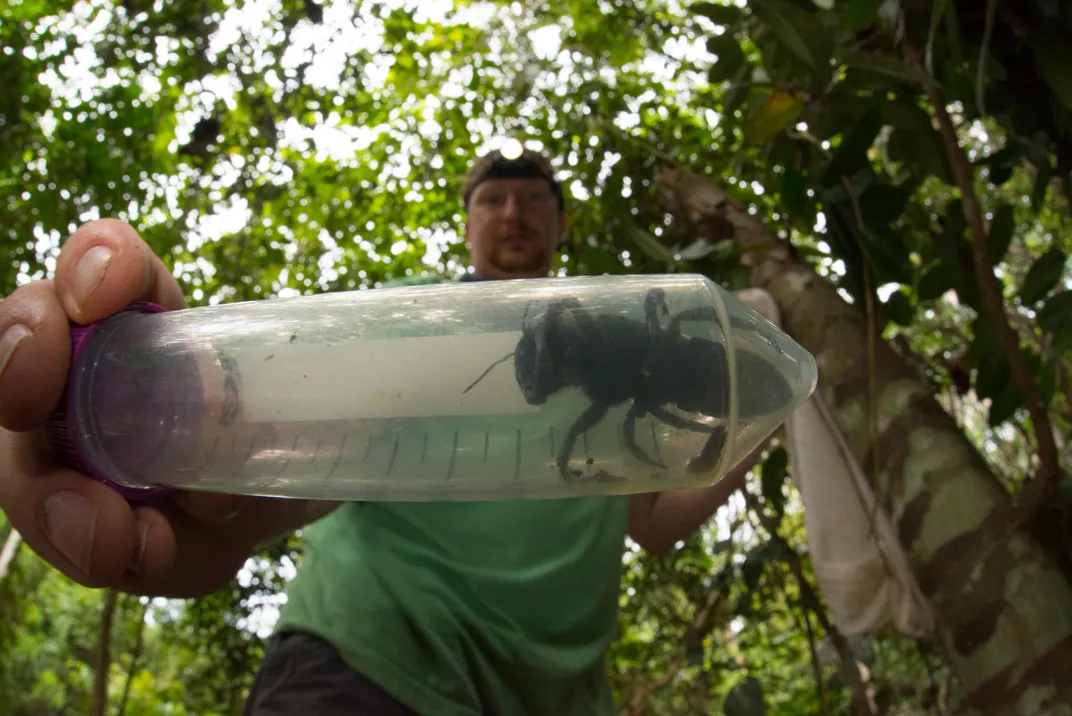World’s Largest Bee Spotted for the First Time in Decades
The Wallace’s giant bee has been seen only a few times since its discovery in 1858; experts weren’t sure it still existed
/https://tf-cmsv2-smithsonianmag-media.s3.amazonaws.com/filer/c3/e4/c3e4c63b-c516-4946-8bcc-0a49de632063/cbolt_01242019_dsc3874_composite_2_lowres.jpg)
In 1858, the famed British naturalist Alfred Russel Wallace discovered a large bee buzzing about on the Indonesian island of Bacan. Now known as Wallace’s giant bee, or Megachile pluto, the critter can grow up to an inch and a half in length, has a wingspan of two and a half inches and boasts an impressive pair of beetle-like mandibles. It is the world’s largest bee—and one of its most elusive, having been seen only a few times since its initial discovery. So a group of researchers and nature enthusiasts were thrilled when they recently spotted a lone female Wallace’s giant bee in Indonesia, marking the first sighting in decades, according to NPR’s Bill Chappell.
The team members had set out to find the bee as part of the Global Wildlife Conservation’s Search for Lost Species program, a mission that took them to a cluster of islands called North Moluccas. Braving heat, humidity and torrential downpours, the bee seekers spent four days peering into termites’ tree nests; Wallace’s giant bees use their their powerful jaws to scrape resin off trees and build burrows inside existing termite mounds. On the final day of the trip, which took place in January, the coveted bee was found inside a nest more than six feet off the ground, reports Patrick Barkham of the Guardian.
Clay Bolt, a natural history photographer who took part in the expedition, was stunned by the creature. “It was absolutely breathtaking to see this flying bulldog of an insect that we weren’t sure existed any more,” he said in a statement. “To actually see how beautiful and big the species is in life, to hear the sound of its giant wings thrumming as it flew past my head, was just incredible.”

Following its discovery in 1858, the Wallace’s giant bee was not seen again until 1981, when entomologist Adam Messer found several in the wild and collected a number of specimens, according to the New York Times’ Douglas Quenqua. In 1991, the French researcher Roch Desmier de Chenon collected a single specimen; he reportedly saw between 20 and 30 of the bees over the course of his research, but did not publish his findings, reports Douglas Main of National Geographic. After that point, the bee seemed to disappear; some experts believed that it had vanished entirely.
“I've been saying it’s thought to be extinct,” Dave Goulson, a biologist at the University of Sussex, tells NPR’s Chappell. “I was happy to hear that's not the case.”
Following their recent discovery, the Search for Lost Species group—which also included entomologist Eli Wyman, biologist Simon Robson, and ecologist Glen Chilton—were able to take the first-ever photos and video of the giant bee. They hope that the announcement of their discovery will call attention to a rare and threatened creature.
The International Union for Conservation on Nature classifies Wallace’s giant bee as a vulnerable species, but no data exists on its possible population size and some experts believe the insect should be listed as endangered. Deforestation and habitat loss pose a risk to the bee’s survival; between 2001 and 2017, Indonesia’s tree forest cover decreased by 15 percent, according to Global Forest Watch. Insect collectors, drawn in by the bee’s impressive size and rarity, constitute another threat. Wallace’s giant bees are not protected, and it is legal to buy and sell the creatures. Last year, a single specimen sold for $9,100 on eBay.
Robin Moore, lead of the Search for Lost Species program, acknowledges that broadcasting the recent discovery could attract the attention of “unscrupulous collectors.” But, he says, the bee’s survival is going to depend on “the appropriate government officials and stakeholders knowing that the bee even exists.”
“By making the bee a world-famous flagship for conservation,” Moore adds, “we are confident that the species has a brighter future than if we just let it quietly be collected into oblivion.”